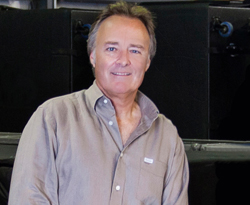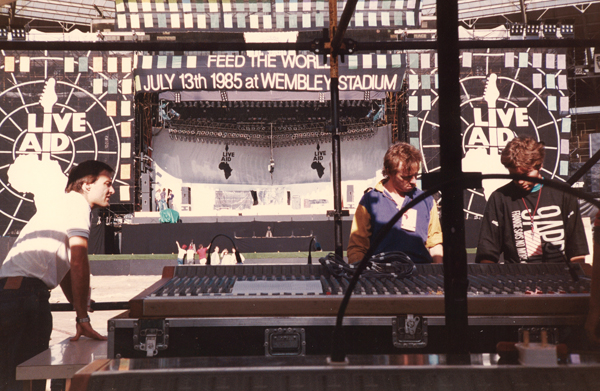
Scarfe ran Hill’s rental department for several years, touring extensively worldwide and refining his craft as a live mix engineer.
“That’s how we all learned in those days – on the road. We were definitely making it up as we went along,” he notes. “You’d do a festival in the pouring rain with the amp racks exposed and think, ‘I’m not doing that again. Next time I’ll put them under the stage.’ Or, you’d stack the speakers a certain way and realize the coverage wasn’t right, so you’d do it differently (the next time). We learned something new every day.”
As Malcolm Hill Associates grew, the company’s roster of clients came to include some of the biggest artists of the era. Scarfe was touring virtually non-stop with a number of them, including AC/DC, a band he went on to mix almost exclusively for a decade.
“Imagine being a 23-year-old kid who ends up with a sound system. By the time he’s 24, he’s working with someone who’s manufacturing and designing equipment. We progressed to two, then three systems, and by 1977, we had five or six sound systems touring Europe.
“By 1979, we came to America with AC/DC, and a year later, we were doing the ‘Back In Black’ tour as well as touring the world with half a dozen other artists. Then, in 1985, we did ‘Live Aid’ at Wembley Stadium. It was a whirlwind, going from virtually nothing to Live Aid in 10 years.”
Across The Pond
By 1983, he and Hill were also doing more business in North America, ultimately deciding to establish a permanent location stateside. “It was a market where we wanted to service our European clients, and we believed we’d be able to do that better with a full-time presence,” Scarfe notes.

The choice of Hagerstown, MD as the new entity’s home base came about for logistical and financial reasons. “I could have located anywhere, but since we were shipping equipment back and forth by sea, somewhere on the mid-Atlantic east coast made sense,” he explains, adding with a laugh, “To be honest, I literally went from Baltimore and started heading west until I found somewhere where the rent was inexpensive. I settled here. I developed the business here. I made friends and married here. It’s served me very well.”
In describing his work with Hill, Scarfe explains that it wasn’t officially a partnership. “We came together because of the needs of my client base, and his manufacturing and design skills. We formed a working relationship that benefited both of us for many years.”
Live Aid remains a career highlight for Scarfe. “It was just unbelievable how it came together,” he says. “Malcolm designed and manufactured all of the speaker boxes, the amplifiers, mixers and monitors. I was on tour in Japan at the time with Frankie Goes To Hollywood, and I flew in on a Wednesday, went straight to Wembley, rehearsed for two days and did the show on Saturday.
“Just to put it into perspective, as a company, we’d never flip-flopped two FOH boards and two monitor systems before. We were both 33, and we’re doing 11-minute changeovers between David Bowie and The Who.”
By the early 90s, Hill decided to focus on his passion for manufacturing gear. Scarfe, however, now firmly established in the U.S., wanted to continue to run MHA Audio as a provider for touring artists. The two came to an agreement, with Scarfe purchasing the U.S. business from Hill in 1992.
